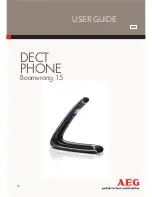
Additional safety information
Small children
Your device and its enhancements may contain small parts. Keep them out of the reach of small children.
Operating environment
This device meets RF exposure guidelines when used either in the normal use position against the ear or when positioned at
least 2,2 centimeters (7/8 inches) away from the body. When a carry case, belt clip, or holder is used for body-worn operation,
it should not contain metal and should position the device the above-stated distance from your body.
To transmit data files or messages, this device requires a quality connection to the network. In some cases, transmission of data
files or messages may be delayed until such a connection is available. Ensure the above separation distance instructions are
followed until the transmission is completed.
Parts of the device are magnetic. Metallic materials may be attracted to the device. Do not place credit cards or other magnetic
storage media near the device, because information stored on them may be erased.
Medical devices
Operation of any radio transmitting equipment, including wireless phones, may interfere with the functionality of inadequately
protected medical devices. Consult a physician or the manufacturer of the medical device to determine if they are adequately
shielded from external RF energy or if you have any questions. Switch off your device in health care facilities when any regulations
posted in these areas instruct you to do so. Hospitals or health care facilities may be using equipment that could be sensitive
to external RF energy.
Implanted medical devices
Manufacturers of medical devices recommend that a minimum separation of 15.3 centimeters (6 inches) should be maintained
between a wireless device and an implanted medical device, such as a pacemaker or implanted cardioverter defibrillator, to
avoid potential interference with the medical device. Persons who have such devices should:
•
Always keep the wireless device more than 15.3 centimeters (6 inches) from the medical device when the wireless device is
turned on.
•
Not carry the wireless device in a breast pocket.
•
Hold the wireless device to the ear opposite the medical device to minimize the potential for interference.
•
Turn the wireless device off immediately if there is any reason to suspect that interference is taking place.
•
Read and follow the directions from the manufacturer of their implanted medical device.
If you have any questions about using your wireless device with an implanted medical device, consult your health care provider.
Hearing aids
Some digital wireless devices may interfere with some hearing aids. If interference occurs, consult your service provider.
Vehicles
RF signals may affect improperly installed or inadequately shielded electronic systems in motor vehicles such as electronic fuel
injection systems, electronic antiskid (antilock) braking systems, electronic speed control systems, and air bag systems. For more
information, check with the manufacturer, or its representative, of your vehicle or any equipment that has been added.
Only qualified personnel should service the device or install the device in a vehicle. Faulty installation or service may be dangerous
and may invalidate any warranty that may apply to the device. Check regularly that all wireless device equipment in your vehicle
is mounted and operating properly. Do not store or carry flammable liquids, gases, or explosive materials in the same
compartment as the device, its parts, or enhancements. For vehicles equipped with an air bag, remember that air bags inflate
with great force. Do not place objects, including installed or portable wireless equipment in the area over the air bag or in the
air bag deployment area. If in-vehicle wireless equipment is improperly installed and the air bag inflates, serious injury could
result.
Using your device while flying in aircraft is prohibited. Switch off your device before boarding an aircraft. The use of wireless
teledevices in an aircraft may be dangerous to the operation of the aircraft, disrupt the wireless telephone network, and may
be illegal.
Potentially explosive environments
Switch off your device when in any area with a potentially explosive atmosphere, and obey all signs and instructions. Potentially
explosive atmospheres include areas where you would normally be advised to turn off your vehicle engine. Sparks in such areas
could cause an explosion or fire resulting in bodily injury or even death. Switch off the device at refueling points such as near
© 2007 Nokia. All rights reserved.
96





































